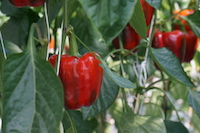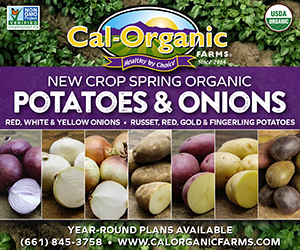Climate continues to complicate efforts to meet growing demand for organic produce, across North America. Whether in the greenhouse or in the field, growers continue to look for ways to overcome weather and expand supply.
Oppenheimer looks north and south
 For Canada-based Oppenheimer, the use of greenhouses to provide year round supplies of organic fresh produce has proven to be an effective way to increase supply. The firm utilizes its growing number of Canadian and Eastern U.S. greenhouses to grow bell peppers and cucumbers during the warm summer months. Simultaneously, it partners with Divemex to add multiple locations that take advantage of the winter growing season in Mexico. “Organic already is at a disadvantage because it yields less and requires greater inputs than conventional,” explains Chris Ford, Organic Category Manager. “That is why we strive to maximize yield based on weather and geography. And the greenhouses provide a protected environment to shield our product from weather damage.”
For Canada-based Oppenheimer, the use of greenhouses to provide year round supplies of organic fresh produce has proven to be an effective way to increase supply. The firm utilizes its growing number of Canadian and Eastern U.S. greenhouses to grow bell peppers and cucumbers during the warm summer months. Simultaneously, it partners with Divemex to add multiple locations that take advantage of the winter growing season in Mexico. “Organic already is at a disadvantage because it yields less and requires greater inputs than conventional,” explains Chris Ford, Organic Category Manager. “That is why we strive to maximize yield based on weather and geography. And the greenhouses provide a protected environment to shield our product from weather damage.”
Oppy dedicates its cold weather efforts toward building and improving the health of its soil. It also uses the cold off-season for propagating plants and maintaining and improving its infrastructure. As a soil-based grower, the company does not anticipate near term impact from any changes in the National Organic Program’s application of the organic label to hydroponic greenhouse crops.
 In the coming years, consumers can expect to see more tomatoes, including grape and on-the-vine, colored bell peppers, and European cucumbers from Oppy’s greenhouses. “These items are growing in both consumption volume and dollars,” says Ford. “We pride ourselves on high quality product with great taste grown by high quality growers we are proud to represent.”
In the coming years, consumers can expect to see more tomatoes, including grape and on-the-vine, colored bell peppers, and European cucumbers from Oppy’s greenhouses. “These items are growing in both consumption volume and dollars,” says Ford. “We pride ourselves on high quality product with great taste grown by high quality growers we are proud to represent.”
San Miguel Produce keeps it local
Oxnard, CA-based San Miguel Produce takes advantage of its Ventura County coastal climate to grow its organic greens in fields year-round. Sales and marketing manager Garrett Nishimori notes that the company’s dark, leafy greens thrive in cool, mild climates. “Some items like collard and kale also seem to enjoy cold weather and even a brief freeze, which is said to sweeten the greens.”
Hot weather brings more challenges. “We face increased insect pressure in the summer months and heat causes greens to wilt,” says Nishimori. “The prolonged California drought brought water challenges, even though our crops are not very water intensive. Water conservation practices include drip irrigation, use of soil moisture readers and leaving ground fallow to manage irrigation restrictions during the drought. We employed soil testing and amendments to deal with salt build-up from the lack of rain.”
San Miguel Produce continues to improve its planting schedules and growing and harvesting practices, including adjustments and improvements to its integrated pest management practices and integrated water management program, to overcome different seasonal challenges. “The only thing that we can do as farmers is to continue to improve on efficiencies, especially with natural resources, be the best stewards of the land, and control what we can,” says Nishimori. “We are always subject to the mercy of Mother Nature. Sometimes we incur large crop and economic losses that are outside of our control.”






